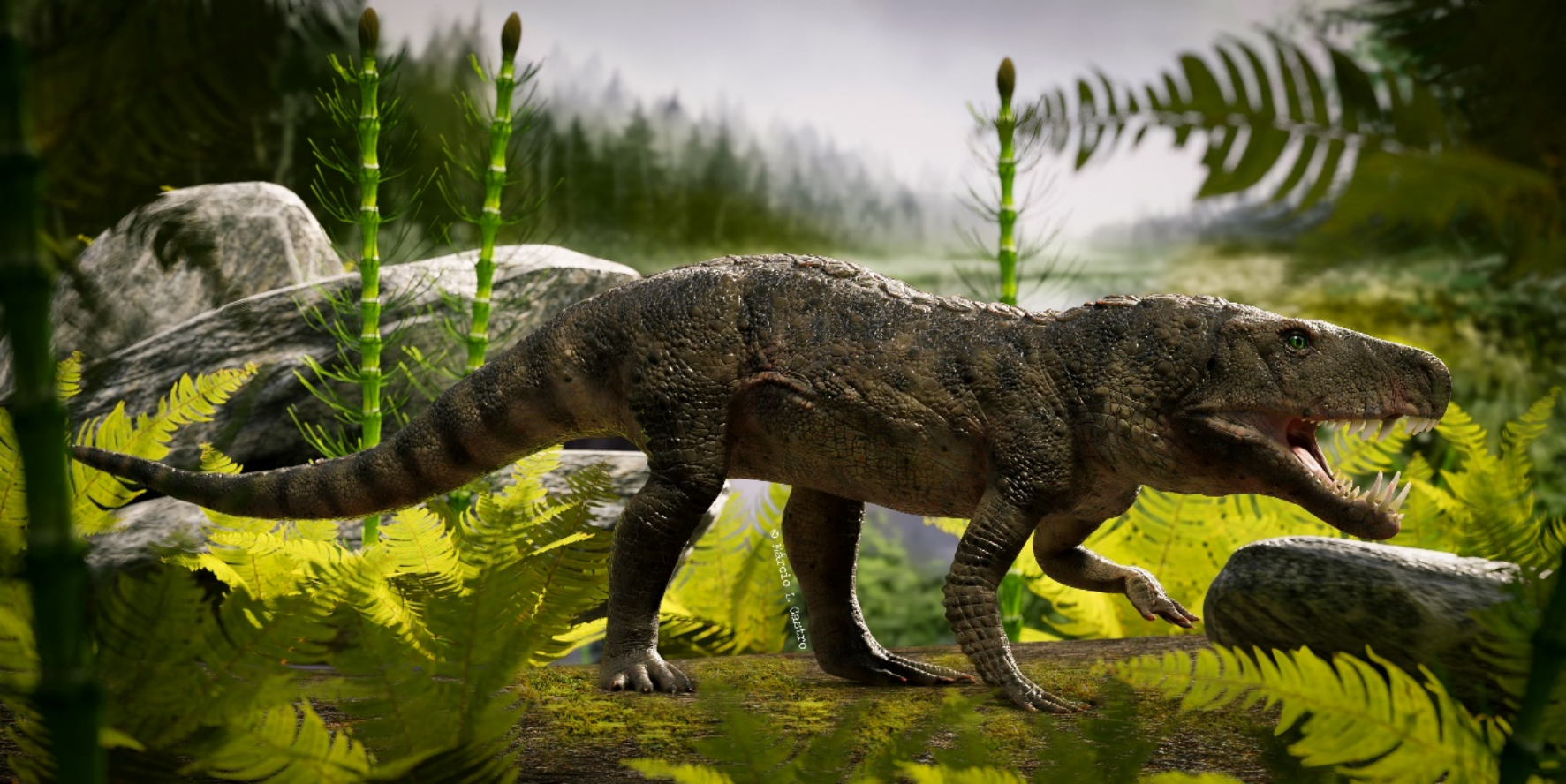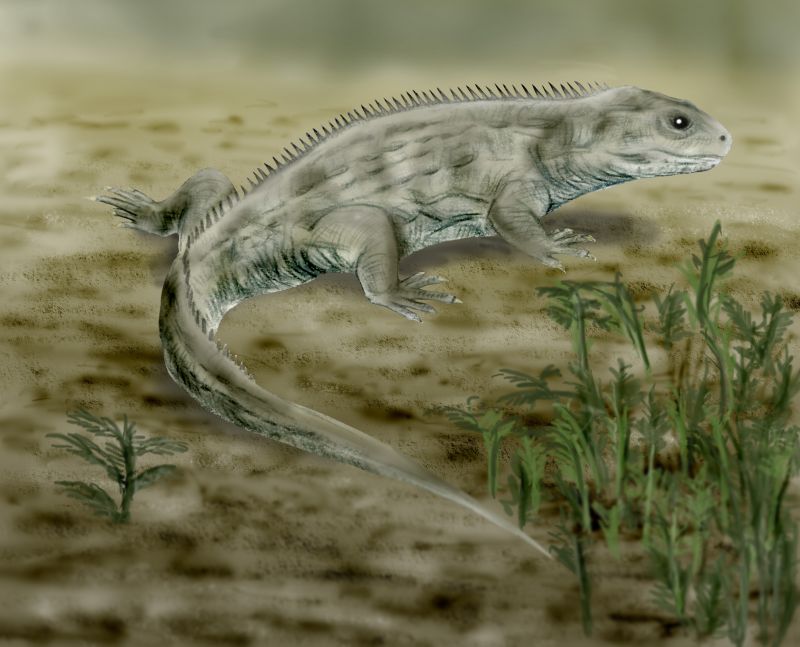|
Ornithosuchus
''Ornithosuchus'' (from , "bird" and , "crocodile") is an extinct genus of pseudosuchians from the Late Triassic (Carnian) Lossiemouth Sandstone of Scotland. It was originally thought to be the ancestor to the carnosaurian dinosaurs (such as ''Allosaurus''), but it is now known to be more closely related to crocodilians than to dinosaurs. Description Despite this relationship to crocodiles, ''Ornithosuchus'' was able to walk on its hind legs, like many dinosaurs. It probably spent most of its time on all fours, though, only moving bipedally when it needed to run rapidly. Its skull also resembled those of theropod dinosaurs, but its more primitive features included the presence of five toes on each foot and a double row of armoured plates along the animal's back. ''Ornithosuchus'' has traditionally been estimated at a length around . Classification A single species of ''Ornithosuchus'' is recognized, ''O. woodwardi''; ''O. taylori'' is a synonym.M. Belén von Baczko and M ... [...More Info...] [...Related Items...] OR: [Wikipedia] [Google] [Baidu] |
Ornithosuchidae
Ornithosuchidae is an extinct family (biology), family of Pseudosuchia, pseudosuchian archosaurs (distant relatives of modern Crocodilia, crocodilians) from the Triassic period. Ornithosuchids were quadrupedal and facultatively bipedal (e.g. like Chimpanzee, chimpanzees), meaning that they had the ability to walk on two legs for short periods of time. They had distinctive, downturned snouts, unique, "crocodile-reversed" ankle bones, and several other features that distinguish them from other archosaurs. Ornithosuchids were geographically widespread during the Carnian and Norian stages of the Late Triassic with members known from Argentina, Brazil, and the United Kingdom. Four genera, comprising ''Ornithosuchus'', ''Venaticosuchus, Dynamosuchus,'' and ''Riojasuchus'' are presently known. The family was first erected by German paleontologist Friedrich von Huene in 1908. Description Skull Ornithosuchids can be identified by the presence of an arched Diastema (dentistry), diastem ... [...More Info...] [...Related Items...] OR: [Wikipedia] [Google] [Baidu] |
Dasygnathoides
''Dasygnathoides'' is an extinct genus of pseudosuchian from the Late Triassic (Carnian) Lossiemouth Sandstone of Scotland. Classification "''Dasygnathus''" ''longidens'' was erected by Thomas Huxley for a maxilla from the Lossiemouth Sandstone in 1877. The genus name '' Dasygnathus'' had already been used for a coleopteran insect, so Oskar Kuhn renamed it ''Dasygnathoides''.Kukn, O., 1961, Fossilium Catalogus I: Animalia, Reptila, supplementum 1, n. 2, p. 1-163. Although synonymized with ''Ornithosuchus'' by Walker (1964), a 2016 study found ''Dasygnathoides'' indeterminate beyond Pseudosuchia. For this reason, many paleontologists consider '''Dasygnathoides a nomem dubium. The lack of synapomorphies shared by ornithosuchids indicates that ''Dasygnathoides'' was not an ornithosuchid as previously thought, but there are no links between it and any other family of pseudosuchians. It has remained impossible to resolve further. The morphology of the maxilla is quite different from ... [...More Info...] [...Related Items...] OR: [Wikipedia] [Google] [Baidu] |
Venaticosuchus
''Venaticosuchus'' is a genus of pseudosuchian archosaurs from the family Ornithosuchidae. Known from a single species, ''Venaticosuchus rusconii'', this genus is described based on an incomplete skull and jaw (as well as a lost partial forelimb and osteoderms) collected from the Late Triassic (Carnian) Ischigualasto Formation in the Ischigualasto-Villa Unión Basin in northwestern Argentina, which was deposited around 230 million years ago. This fossil material has been termed the holotype specimen PVL 2578. ''Venaticosuchus'' incorporated a myriad of features present in the other two genera of ornithosuchids, '' Ornithosuchus'' and '' Riojasuchus''. However, it also had several unique traits, relating to the lower jaw. Reconstructions of the jaw musculature of ''Venaticosuchus'' showed that it had a slow, strong bite, similar to those of herbivorous aetosaurs such as ''Desmatosuchus''. ''Venaticosuchus'' and other ornithosuchids were likely specialized scavengers, due to a ... [...More Info...] [...Related Items...] OR: [Wikipedia] [Google] [Baidu] |
Dynamosuchus
''Dynamosuchus'' is an extinct genus of pseudosuchian archosaurs from the family Ornithosuchidae. It is known from a single species, ''Dynamosuchus collisensis'', which is based on a partial skeleton from the Santa Maria Formation of Brazil. ''Dynamosuchus'' is considered a close relative of '' Venaticosuchus'', which is known from the Ischigualasto Formation of Argentina. Ornithosuchids are one of many groups which lived in the Santa Maria and Ischigualasto Formations, which formed at approximately the same time (the Carnian stage of the Late Triassic) and were ecologically similar. As a large scavenging reptile, ''Dynamosuchus'' helps to illuminate the trophic structure of the Santa Maria Formation. It also supports the hypothesis that ornithosuchids had diversified throughout South America by the start of the Carnian, and were not originally endemic to the Ischigualasto-Villa Unión Basin. Discovery ''Dynamosuchus'' is known from a single partial skeleton, CAPPA/UFSM 0248, s ... [...More Info...] [...Related Items...] OR: [Wikipedia] [Google] [Baidu] |
Riojasuchus
''Riojasuchus'' is an extinct genus of ornithosuchid archosaur from the Late Triassic (Norian) of Argentina. Ornithosuchidae was a widespread family of facultatively bipedal pseudosuchians (crocodilian-line archosaurs) with adaptations for scavenging. ''Riojasuchus'' is notable as one of the youngest and most complete members of the family. The type and only known species, ''Riojasuchus tenuisceps'', was named and described by José Bonaparte in 1967. It was one of the first of many well-preserved Triassic archosaurs to be discovered in Argentina. The holotype specimen, PVL 3827, was found in the Los Colorados Formation of the Ischigualasto-Villa Unión Basin in northwestern Argentina. Discovery and naming The holotype specimen is PVL 3827, consisting of a complete skull and mandibles, as well as a nearly complete postcranial skeleton, and it was collected during the late 1960s. Three other specimens are known. PVL 3828 is almost as complete as the holotype, including a nearly ... [...More Info...] [...Related Items...] OR: [Wikipedia] [Google] [Baidu] |
Pseudosuchia
Pseudosuchia, from Ancient Greek ψεύδος (''pseúdos)'', meaning "false", and σούχος (''soúkhos''), meaning "crocodile" is one of two major divisions of Archosauria, including living crocodilians and all archosaurs more closely related to crocodilians than to birds. Pseudosuchians are also informally known as "crocodilian-line archosaurs", in contrast to the "bird-line archosaurs" or Avemetatarsalia. Despite Pseudosuchia meaning "false crocodiles", the name is a misnomer as true crocodilians are now defined as a subset of the group. The clade Pseudosuchia is potentially equivalent to another term, Crurotarsi, even though the latter has a different, Node-based taxon, node-based definition: "all taxa the least inclusive clade containing ''Rutiodon carolinensis'' (Emmons, 1856), and ''Crocodylus niloticus'' (Laurenti, 1768)." Many paleontologists of the late 20th century took this proposal for granted, using Crurotarsi as the term for crocodilian ancestors. In 2011, a m ... [...More Info...] [...Related Items...] OR: [Wikipedia] [Google] [Baidu] |
Lossiemouth Sandstone
The Lossiemouth Sandstone is a Middle to Late Triassic (Ladinian to Norian) age geological formation. It is exposed on the south side of the Moray Firth near Lossiemouth and near Golspie in Sutherland. Dinosaur remains are among the fossils that have been recovered from the formation.Weishampel et al., 2004, "Dinosaur distribution." pp.517-607 Fossil content See also * List of dinosaur-bearing rock formations ** List of stratigraphic units with indeterminate dinosaur fossils * List of fossiliferous stratigraphic units in Scotland * Ischigualasto Formation, contemporaneous fossiliferous formation of the Ischigualasto-Villa Unión Basin, Argentina * Candelária Formation, contemporaneous fossiliferous formation of the Paraná Basin in southeastern Brazil * Molteno Formation, contemporaneous fossiliferous formation of the Karoo Basin in southern Africa * Fremouw Formation The Fremouw Formation is a Triassic-age rock formation in the Transantarctic Mountains of the R ... [...More Info...] [...Related Items...] OR: [Wikipedia] [Google] [Baidu] |
Allosaurus
''Allosaurus'' ( ) is an extinct genus of theropod dinosaur that lived 155 to 145 million years ago during the Late Jurassic period ( Kimmeridgian to late Tithonian ages). The first fossil remains that could definitively be ascribed to this genus were described in 1877 by Othniel C. Marsh. The name "''Allosaurus''" means "different lizard", alluding to its lightweight , which Marsh believed were unique. The genus has a very complicated taxonomy and includes at least three valid species, the best known of which is ''A. fragilis''. The bulk of ''Allosaurus'' remains come from North America's Morrison Formation, with material also known from the Alcobaça Formation and Lourinhã Formation in Portugal. It was known for over half of the 20th century as '' Antrodemus'', but a study of the abundant remains from the Cleveland-Lloyd Dinosaur Quarry returned the name "''Allosaurus''" to prominence. As one of the first well-known theropod dinosaurs, it has long attracted attention ... [...More Info...] [...Related Items...] OR: [Wikipedia] [Google] [Baidu] |
Late Triassic
The Late Triassic is the third and final epoch (geology), epoch of the Triassic geologic time scale, Period in the geologic time scale, spanning the time between annum, Ma and Ma (million years ago). It is preceded by the Middle Triassic Epoch and followed by the Early Jurassic Epoch. The corresponding series (stratigraphy), series of rock beds is known as the Upper Triassic. The Late Triassic is divided into the Carnian, Norian and Rhaetian Geologic time scale, ages. Many of the first dinosaurs evolved during the Late Triassic, including ''Plateosaurus'', ''Coelophysis'', ''Herrerasaurus'', and ''Eoraptor''. The Triassic–Jurassic extinction event began during this epoch and is one of the five major mass extinction events of the Earth. Etymology The Triassic was named in 1834 by Friedrich August von Namoh, Friedrich von Alberti, after a succession of three distinct rock layers (Greek meaning 'triad') that are widespread in southern Germany: the lower Buntsandstein (colourful ... [...More Info...] [...Related Items...] OR: [Wikipedia] [Google] [Baidu] |
Coleoptera
Beetles are insects that form the Taxonomic rank, order Coleoptera (), in the superorder Holometabola. Their front pair of wings are hardened into wing-cases, elytra, distinguishing them from most other insects. The Coleoptera, with about 400,000 described species, is the largest of all orders, constituting almost 40% of described arthropods and 25% of all known animal species; new species are discovered frequently, with estimates suggesting that there are between 0.9 and 2.1 million total species. However, the number of beetle species is challenged by the number of species in Fly, dipterans (flies) and hymenopterans (wasps). Found in almost every habitat except the sea and the polar regions, they interact with their ecosystems in several ways: beetles often feed on plants and fungi, break down animal and plant debris, and eat other invertebrates. Some species are serious agricultural pests, such as the Colorado potato beetle, while others such as Coccinellidae (ladybirds or ... [...More Info...] [...Related Items...] OR: [Wikipedia] [Google] [Baidu] |
Fossils Of Scotland
A fossil (from Classical Latin , ) is any preserved remains, impression, or trace of any once-living thing from a past geological age. Examples include bones, shells, exoskeletons, stone imprints of animals or microbes, objects preserved in amber, hair, petrified wood and DNA remnants. The totality of fossils is known as the ''fossil record''. Though the fossil record is incomplete, numerous studies have demonstrated that there is enough information available to give a good understanding of the pattern of diversification of life on Earth. In addition, the record can predict and fill gaps such as the discovery of '' Tiktaalik'' in the arctic of Canada. Paleontology includes the study of fossils: their age, method of formation, and evolutionary significance. Specimens are sometimes considered to be fossils if they are over 10,000 years old. The oldest fossils are around 3.48 billion years to 4.1 billion years old. Early edition, published online before print. Th ... [...More Info...] [...Related Items...] OR: [Wikipedia] [Google] [Baidu] |








